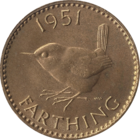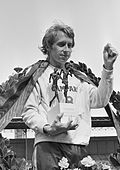Wikipedia:Main Page history/2020 July 10
From today's featured articleHistorically, the British farthing was a continuation of the English farthing, a coin struck by English monarchs prior to the Act of Union 1707 that was worth a quarter of an old penny (1⁄960 of a pound sterling). Only pattern farthings were struck under Queen Anne. The coin was struck intermittently through much of the 18th century, but counterfeits became so prevalent the Royal Mint ceased striking them after 1775. The next farthings were the first ones struck by steam power, in 1799 by Matthew Boulton at his Soho Mint. The Royal Mint resumed production in 1821. The farthing was struck regularly under George IV, William IV and in most years of Queen Victoria's long reign. The coin continued to be issued in most years of the first half of the 20th century, and in 1937 it finally received its own design, a wren (pictured). By the 1950s, inflation had eroded its value. It ceased to be struck after 1956 and was demonetised in 1961. (Full article...)
Recently featured:
Did you know ...National anthem of the Bahamas
|
In the news
On this dayJuly 10: Independence Day in The Bahamas (1973)
|
From today's featured list
Winners of the New York City Marathon include 35 men and 30 women who have won the open division, and 9 men and 7 women who have won the wheelchair division. The New York City Marathon, one of the six World Marathon Majors, is a 26.2-mile (42.2 km) race which has been held in New York City since 1970. It is the largest marathon in the world; since 2013, every race except one has had over 50,000 finishers. Gary Muhrcke won the first race in a time of 2:31:38. The following year, Beth Bonner became the first female finisher, winning the race in 2:55:22. Norwegian runner Grete Waitz dominated the women's marathon between 1978 and 1989, winning nine of the eleven races during that period; her nine wins are the most of any runner at the New York City Marathon. In the men's race, Bill Rodgers (pictured) has won the most times, doing so in four consecutive years, from 1976 to 1979. A wheelchair race has been held since 2000, when 72 people finished: Kamel Ayari won the men's race, and Anh Nguyen Thi Xuan won the women's. (Full list...)
Today's featured picture

|
The Wyoming Territory was an organized incorporated territory in the western United States that existed from July 25, 1868, until July 10, 1890, when it was admitted to the Union as the state of Wyoming. This picture is a historical depiction of the Wyoming Territory's coat of arms, as illustrated by American engraver Henry Mitchell in State Arms of the Union, published in 1876 by Louis Prang. The escutcheon depicts a railroad train in front of a mountainous landscape in the top half, agricultural tools in the bottom left, and an arm holding a sword in the bottom right. Under the shield is the Latin motto Cedant arma togae (misspelled in this depiction as Oedant arma toga), literally meaning "Let arms yield to the toga", but often translated as "Let military power be subject to civil authority". Illustration credit: Henry Mitchell; restored by Andrew Shiva
Recently featured:
|
Other areas of Wikipedia
- Community portal – Bulletin board, projects, resources and activities covering a wide range of Wikipedia areas.
- Help desk – Ask questions about using Wikipedia.
- Local embassy – For Wikipedia-related communication in languages other than English.
- Reference desk – Serving as virtual librarians, Wikipedia volunteers tackle your questions on a wide range of subjects.
- Site news – Announcements, updates, articles and press releases on Wikipedia and the Wikimedia Foundation.
- Village pump – For discussions about Wikipedia itself, including areas for technical issues and policies.
Wikipedia's sister projects
Wikipedia is hosted by the Wikimedia Foundation, a non-profit organization that also hosts a range of other projects:
Free media repository
Wiki software development
Wikimedia project coordination
Free textbooks and manuals
Free knowledge base
Free-content news
Collection of quotations
Free-content library
Directory of species
Free learning tools
Free travel guide
Dictionary and thesaurus




